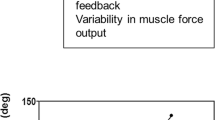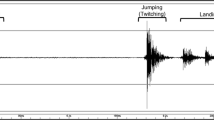Summary
-
1.
Locusts perform a visual behavior known as peering before jumping to targets. Peering consists of a side to side translational movement of the head. Wallace (1959) first proposed that this behavior is performed in order to obtain depth information through motion parallax. The present study analyzes more quantitatively the role of peering in the locust's (Schistocerca americana) estimation of distance in an attempt to understand the neural mechanisms involved.
-
2.
Jump velocity was found to be related monotonically to target distance and was used as a measure of the locust's judgement of target distance.
-
3.
By presenting locusts with a target which moved laterally while they peered (artificial parallax), it was possible to simulate the motion parallax of a target at any distance. Jump velocities elicited by means of artificial parallax were the same as jump velocities elicited by the corresponding real distances, demonstrating that locusts use motion parallax as a cue to distance.
-
4.
By moving the target in the same direction but further than the locust's head it was possible to simulate targets whose motion parallax specified a position behind the animal. Locusts jump forward to such paradoxical stimuli with the jump velocity appropriate for targets located at the absolute value of the simulated distance. This suggests that locusts are insensitive to the relation between the direction of head and image motion.
-
5.
Measurement of jump velocity in locusts with one eye occluded revealed an interaction between the parallax signals from the two eyes — locusts appear to sum (or average) the motion perceived in each eye.
-
6.
Jump velocity is predicted more accurately by target distance than by either image displacement or image velocity during peering. This implies that the locust's computation of target distance involves signals concerning its own head motion.
Similar content being viewed by others
References
Arbas EA (1983) Aerial manoeuvring reflexes in flightless grass-hoppers. J Exp Biol 107:509–513
Bennet-Clark HC (1975) The energetics of the jump the locust Schistocerca gregaria. J Exp Biol 82:105–121
Bennet-Clark HC, Alder GM (1979) The effect of air resistance on jumping performance in insects. J Exp Biol 63:53–83
Cartwright BA, Collett TS (1979) How honey-bees know their distance from a near-by visual landmark. J Exp Biol 82:367–372
Cheng K, Collett TS, Pickhard A, Wehner R (1987) The use of visual landmarks by honeybees: bees weight landmarks according to their distance from the goal. J Comp Physiol A 161:469–475
Cloarec A (1986) Distance and size discrimination in a water stick insect, Ranatra linearis (Heteroptera). J Exp Biol 120:59–77
Collett TS (1978) Peering — a locust behaviour pattern for obtaining motion parallax information. J Exp Biol 76:237–241
Collett TS (1988) How ladybirds approach nearby stalks: a study of visual selectivity and attention. J Comp Physiol A 163:355–363
Collett TS, Harkness LIK (1982) Depth vision in animals. In: Ingle DJ, Goodale MA, Mansfield RJW (eds) Analysis of Visual Behavior. Cambridge, MIT Press, pp 111–176
Collett TS, Land MF (1975) Visual control of flight behaviour in the hoverfly Syritta pipiens L. J Comp Physiol 99:1–66
Collett TS, Land MF (1978) How hoverflies compute interception courses. J Comp Physiol 125:191–204
Cooler RJ (1973) Flight and landing posture in hoppers of Schistocerca gregaria (Forsk). Acrida 2:307–317
Eriksson ES (1985) Attack behaviour and distance perception in the australian bulldog ant Myrmecia nigriceps. J Exp Biol 119:115–131
Goulet M, Campan R, Lambin M (1981) The visual perception of relative distances in the wood cricket, Nemobius sylvestris. Physiological Entomology 6:357–367
Heitler WJ, Burrows M (1977a) The locust jump. I. The motor programme. J Exp Biol 66:203–219
Heitler WJ, Burrows M (1977b) The locust jump. II. Neural circuits of the motor programme. J Exp Biol 66:221–2241
Kirchner WH, Srinivasan MV (1989) Freely flying honeybees use image motion to estimate object distance. Naturwissenschaften 76:281–282
Lehrer M, Srinivasan MV, Zhang SW, Horridge GA (1988) Motion cues provide the bee's visual world with a third dimension. Nature 332:356–357
Maldonado H, Rodriguez E (1972) Depth perception in the praying mantis. Physiol Behav 8:751–759
Srinivasan MV, Lehrer M, Zhang SW, Horridge GA (1989) How honeybees measure their distance from objects of unknown size. J Comp Physiol A 165:605–613
Rossel S (1983) Binocular stereopsis in an insect. Nature 302:821–822
Rossel S (1986) Binocular spatial localization in the praying mantis. J Exp Biol 120:265–281
Wallace GK (1958a) Visual perception and behavior in the desert locust. Anim Behav 6:242–243
Wallace GK (1958b) Some experiments on form perception in the nymphs of the desert locust Schistocerca gregaria Forskål. J Exp Biol 35:765–775
Wallace GK (1959) Visual scanning in the desert locust Schistocerca gregaria Forskål. J Exp Biol 36:512–525
Wehner R (1981) Spatial vision in arthropods. In: Autrum H (ed) Comparative physiology and evolution of vision in invertebrates. (Handbook of Sensory Physiology, vol VII/6c). Springer, Berlin Heidelberg New York, pp 287–616
Wehner R, Horn E (1975) The effect of object distance on pattern preferences in the walking fly, Drosophila melanogaster. Experientia 31:641–643
Author information
Authors and Affiliations
Rights and permissions
About this article
Cite this article
Sobel, E.C. The locust's use of motion parallax to measure distance. J Comp Physiol A 167, 579–588 (1990). https://doi.org/10.1007/BF00192653
Accepted:
Issue Date:
DOI: https://doi.org/10.1007/BF00192653




